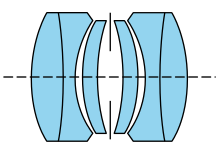Paul Rudolph (physicist)
Paul Rudolph (born November 14, 1858 in Kahla ; † March 8, 1935 in Nuremberg ) was a German optician .
Rudolph, who holds a doctorate, is one of the most important employees at Carl Zeiss and Ernst Abbe . Before the First World War he worked as a scientist in what was then Carl Zeiss (company) in Jena and headed the plant's photographic department for many years. There he was instrumental in the development of a number of legendary camera lenses. The first was the Protar (1889), the first anastigmat . An anastigmat corrects the important aberration of astigmatism and came onto the market a little earlier than the Cooke triplet, which is also anastigmatic but easier to produce . This was followed by the Planar (1896), the Unar (1899) and the so-called "eagle eye" of photography, the Tessar (1902).
Due to the great commercial success of the lenses he developed for Zeiss, Rudoph made some wealth himself through license fees and was able to withdraw into private life early in 1911 . However, due to inflation , he lost a large part of his wealth. After working briefly at Zeiss again, he accepted an offer from Zeiss competitor Hugo Meyer from Görlitz in Saxony in 1920 at the age of 61 .
He contributed his preliminary work on the Plasmat lens to Meyer-Optik . The Plasmat is an interchangeable lens completely corrected for color errors with the then sensational light intensity of 1: 4. Inspired by the requirements of the growing film industry , he developed the so-called Kino Plasmat with a light intensity of 1: 2 as early as 1922 (patent filing in the USA in 1922) . A variant of the Kino Plasmat with 1: 1.5 followed in 1926. At the time, this was the "fastest" lens in the world. Leading film cameras of the time such as B. the Bolex brand were equipped with Meyer lenses in the interwar period.
A Plasmat 70 f / 2.7 was the standard lens of a 35mm camera (3x4) first produced in 1933 . From 1935 the producer operated as Kleinbild-Plasmat-Gesellschaft and from 1935 as Rudolph & Co. Kamerabau , Berlin .
Rudolph has been the namesake for the Rudolph Glacier in Antarctica since 1960 .
literature
- Christian Hofmann: Rudolph, Paul. In: New German Biography (NDB). Volume 22, Duncker & Humblot, Berlin 2005, ISBN 3-428-11203-2 , p. 201 f. ( Digitized version ).
Web links
- Bolex Collector: Hugo Meyer
Individual evidence
- ↑ Listed with title in the company magazine Contax News , No. 45 from 1996.
- ^ Kingslake, Rudolf (1989) The History of the Photographic Lens. Academic Publishers Inc., pp. 86f
- ^ Kingslake, Rudolf (1989) A History of the Photographic Lens. Academic Press Incorporated, p. 95
- ↑ Bolex Collector: Hugo Meyer
- ↑ ukcamera.com: Plasmat Roland
| personal data | |
|---|---|
| SURNAME | Rudolph, Paul |
| BRIEF DESCRIPTION | German optician |
| DATE OF BIRTH | November 14, 1858 |
| PLACE OF BIRTH | Kahla , Thuringia |
| DATE OF DEATH | March 8, 1935 |
| Place of death | Nuremberg |


